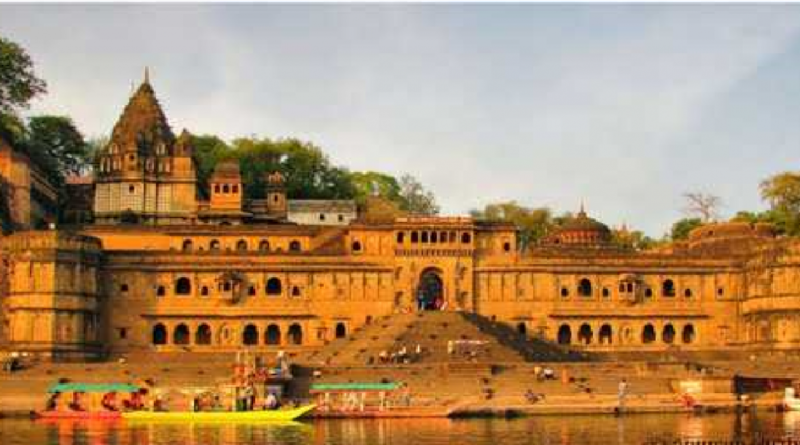The glory of ancient city of Mahishmati from Kartavirya Arjuna to Ahilya Bai Holkar!
The magnificent Mahishmati of Rajamouli’s Bahubali was not all fiction. The grandeur presented by the famous movie was once a reality in the real Mahishmati.
Mahishmati was an ancient city in present-day central India. It was located in present-day Madhya Pradesh, on the banks of Narmada River.
It is mentioned in several ancient texts, and was ruled by the legendary Haihaya ruler Kartavirya Arjuna. Mahishmati was the most important city in the southern part of the Avanti kingdom, and later served as the capital of the Anupa Kingdom. It is even mentioned in the 13th century Paramara inscription.
Patanjali mentions that a traveler starting out from Ujjayini saw the sunrise at Mahishmati. It had replaced Ujjayani as the Avanti kingdom’s capital for a brief period. From these references several cities in Madhya Pradesh, located along the Narmada river, are claimed to be the ancient Mahishmati, mainly today’s Maheshwar.
Maheshwar is believed to be built on the site, where the ancient city of Mahishmati stood. It was the capital of Somvanshya Kartavirya Arjuna, (Shree Shastrarjun) who is mentioned in the Sanskrit epics Ramayana and Mahabharata.
According to a popular legend, one day the King Kartavirya Arjuna and his 500 wives went to the river for a picnic. When his wives wanted a vast area to play, the King stopped the mighty river Narmada with his 1000 arms.
While they were all enjoying themselves, Ravana flew by in his Pushpak Vimana. Downstream, when he saw the dry river bed, he thought it was an ideal place to pray to Lord Shiva.
He made a shivalinga out of sand and began to pray. When Kartavirya Arjuna’s wives were done playing and they stepped out of the river bed, he let the waters flow. The voluminous river flowed down sweeping Ravana’s shivalinga along, messing up his prayers.
Furious, Ravana tracked Arjuna and challenged him. But the mighty Ravana was in for a huge surprise. Kartavirya Arjuna with his 1000 arms pinned Ravana to the ground.
Then he placed 10 lamps on his heads and one on his hand. After tying up Ravana, he dragged him home and tied him up to the cradle pole of his son as a lamp post.
A humiliated Ravana stayed prisoner until his release was secured.
Jamadagni rishi, Renuka Devi and Lord Parashurama with whom Kartavirya Arjuna’s story is closely associated also lived nearby the city of Mahishmati. It was this Kartavirya Arjuna’s act which lead Parashurama to wage war against Kshatriyas.
In Mahabharata, there is a narration of an unusual tradition where in marriage as a civil institution was not compulsory in Mahishmati unlike in rest of Aryavarta.
As per the legend, there was a Nishada king named Nila who ruled over Mahishmati.
King Nila had a daughter who was very beautiful. So much so that Agni fell in love with her which was reciprocated. The princess always used to stay near the sacred fire, of Yajna.
It was said that fire from Yajna would not vanquish until the gentle breath from Princess’s lips touched it.
Agni, assuming the form of a Brahman starts courting with the princess for long. When Nila was angered by this, Agni became furious and showed his true form. Nila prayed to him and pacified Agni then grants a boon to Nishada Kingdom that he will always protect it.
Nila also announced pure love is a legitimate action in the kingdom. Liberated from the orthodoxy of marriage, women of Mahishmati enjoyed freedom of choosing their partner that was then unheard off elsewhere in aryavarta.
Years later, after the epic Kurukshetra war when the victorious Yudhishthira planned on Rajasuya Yagna by winning over everyone else on Earth.
Sahadeva, the youngest of Pandavas knowing that Lord Agni was protecting the Nishada kingdom, prays to Lord Agni successfully and there upon moves to Saurashtra kingdom.
Even to this day, the Sahasrarjun temple at Maheshwar lights 11 lamps in honour of Lord Agni blessing the Kingdom and also as reminder of their king’s valour against Ravana.
In the late eighteenth century, Maheshwar served as the capital of the great Maratha queen Rajmata Ahilya Bai Holkar.
She embellished the city with many buildings and public works, and it is home to her palace, as well as numerous temples, a fort, and riverfront ghats (broad stone steps which step down to the river).
Ahilyabai’s capital at Maheshwar was the scene of literary, musical, artistic and industrial enterprise. She entertained the famous Marathi poet, Moropant and the shahir, Anantaphandi from Maharashtra, and also patronised the Sanskrit scholar, Khushali Ram. Craftsmen, sculptors and artists received salaries and honours at her capital, and she even established a textile industry in the city of Maheshwar.
Jagadguru Kripaluji Maharaj has performed various akhand sankirtan outside shiva temple at maheshwar for more than months. Even though Kripaluji was from mahu (30 km from maheshwar), he frequently visited this place in his early life with devotees of lord Krishna to perform sankirtan on the banks of the Narmada river in Maheshwar.
Mahishmati is not just a city, it’s a breathing thriving civilization which has its origin in the Puranas. This city stands proof to the various facts from the Ramayana, Mahabharatha time which are often referred to as Mythology by our historians.
Dr Sindhu Prashanth

